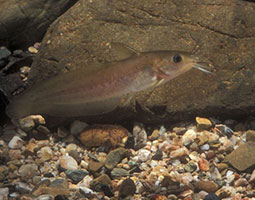Tandanus tandanus
Description

The Freshwater Catfish (Tandanus tandanus) is a scale-less species of fish with a solid, cylindrical body that is brown to olive green, reddish or even purplish colour above, and an underbelly that is pale in colour. Their front dorsal fin is short and their tail fin is eel-like (sometimes giving it the common name eel tail catfish). Like most catfish they have a large head, small eyes, smooth slimy skin and a down-turned mouth with fleshy lips. The mouth is encircled by four pairs of slender whisker like barbels. They are a large freshwater fish that can grow to 90cm (average 45cm) long and weigh up to 7kg.
Spawning occurs during the spring and summer months when the temperature of the water increases to around 20-24°C. Male catfish will pair-up with a female, and a couple of weeks before spawning the male will construct a circular nest made from gravel or pebbles which is up to 1.5m in diameter. The centre of the nest will contain a depression in which the female lays up to 20,000 spherical, non-adhesive eggs that are 3mm in diameter. One of the parents will then aerate and protect the eggs until the eggs hatch about a week later. These catfish can produce multiple spawnings each season, and are sexually mature at 3-5 years of age and live up to 10 years.
Freshwater Catfish are only found in Australia, including in most drainages of the Murray-Darling River and also in coastal rivers and creeks from north Queensland to Sydney. They prefer to live in creeks, rivers, lakes and ponds that are slow moving and contain bankside vegetation. Within these habitats they can be found swimming close to the sand, gravel or pebble bottoms. Although they spend most of their time alone, juveniles may congregate in small schools.
Adaptations
- Possess barbels which are sensory organs used in highly turbid waters to search for prey
- Downwards facing mouth to take prey from the bottom of the waterway
- Both the front dorsal and pectoral fins possess a sharp serrated spine that are venomous and can inflict a painful injury
Feeding relationships
- What I eat: Aquatic insects, crustaceans, molluscs and small fish
- What eats me: Large carnivorous fish (e.g. Barramundi), birds (e.g. Egret), turtles
Interesting facts
Freshwater catfish were once a very popular recreational fishing species as they are considered excellent eating. However, fishing for Freshwater Catfish is now restricted in many areas due to the decline in their local populations.